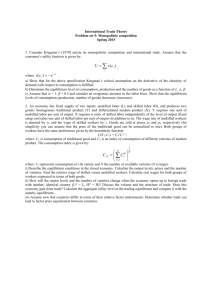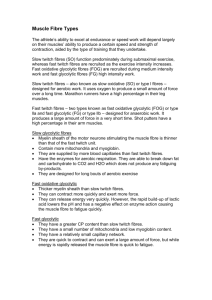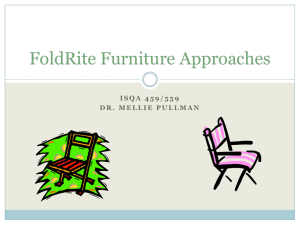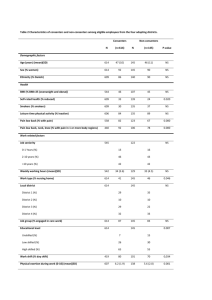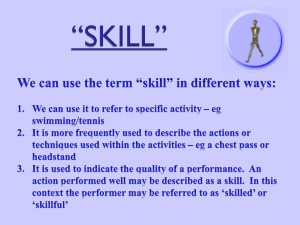handout
advertisement
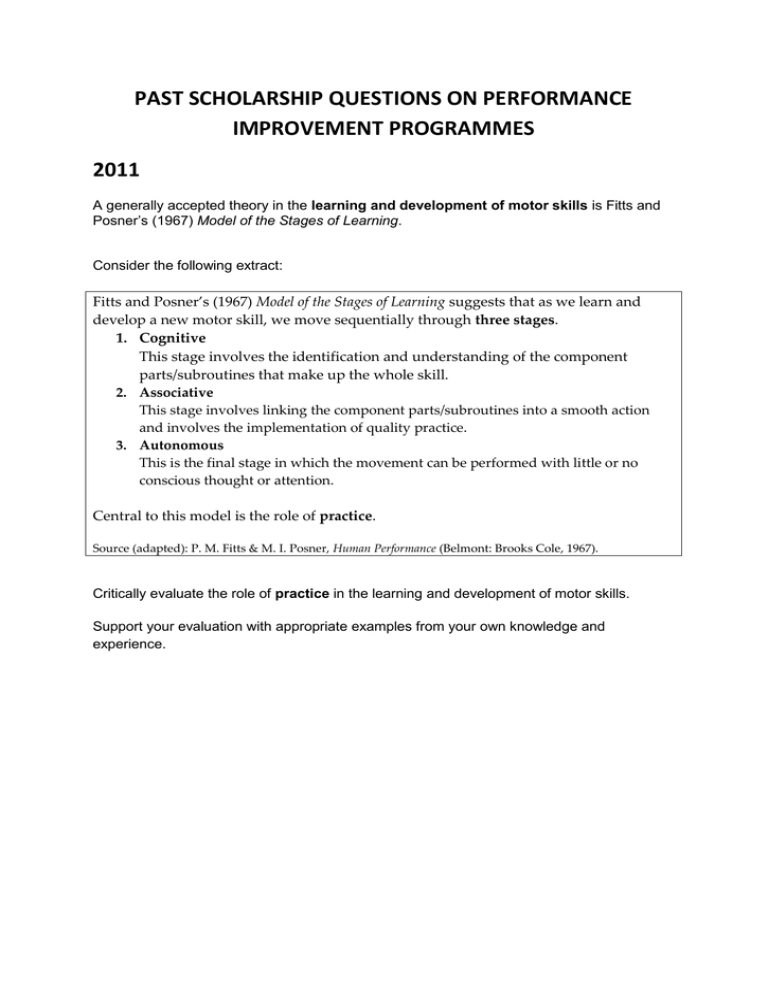
PAST SCHOLARSHIP QUESTIONS ON PERFORMANCE IMPROVEMENT PROGRAMMES 2011 A generally accepted theory in the learning and development of motor skills is Fitts and Posner’s (1967) Model of the Stages of Learning. Consider the following extract: Fitts and Posner’s (1967) Model of the Stages of Learning suggests that as we learn and develop a new motor skill, we move sequentially through three stages. 1. Cognitive This stage involves the identification and understanding of the component parts/subroutines that make up the whole skill. 2. Associative This stage involves linking the component parts/subroutines into a smooth action and involves the implementation of quality practice. 3. Autonomous This is the final stage in which the movement can be performed with little or no conscious thought or attention. Central to this model is the role of practice. Source (adapted): P. M. Fitts & M. I. Posner, Human Performance (Belmont: Brooks Cole, 1967). Critically evaluate the role of practice in the learning and development of motor skills. Support your evaluation with appropriate examples from your own knowledge and experience. 2010 Putting skill learning theory into practice is part of a programme designed to improve the performance of ourselves or others. Consider the following extract: “Physical education needs to come to terms with itself as to what it really knows (and doesn’t know), about the learning and teaching of physical skills. For thousands of years, nature has provided people with a means for developing motor skills, one which relies on an almost thoughtless, unconscious process of observation, recognition, imitation, and experimentation. Physical education, most noticeably through its textbooks and teacher education curricula, advocates that teachers of physical skills intervene in nature’s process, on the premise that skill learning can be accelerated and unskilled people can be ‘fixed’.” Source (adapted): F. Rokosz and R. Laptad, ‘On the Learning and Teaching of Physical Skills’, JOPERD – The Journal of Physical Education, Recreation & Dance vol 68 (1997). Critically evaluate the suggestion that through the application of skill learning theory, unskilled people can be “fixed”. Illustrate your evaluation with appropriate examples from your own knowledge and experience. 2009 Consider the following three extracts demonstrating a range of opinions on whether athletes are made or born: “Ever dreamed of standing atop a podium and having a medal placed around your neck? … How much is athletic prowess due to genetics and how much is due to training and environment?” Torgan (2002) “Athletic records are broken year after year, and the limits of human performance continue to be debated … Is there any limit?”Quinn (2008) “One possibility is that some people are simply natural born superhumans … – the key to gaining the ultimate competitive advantage may be hidden in our genes.” Geddes (2007) Drawing on your knowledge and experience of factors that lead to performance improvement, critically evaluate whether athletes are made or born. Illustrate your answer with appropriate examples from your own knowledge and experience. PAST SCHOLARSHIP STUDENT: 2010 Question Three (see question above) This statement of “skill learning can be accelerated and unskilled people can be ‘fixed’” is true in the sense that many people may have genetic predispositions that would make them a great athlete but without the correct training and other factors they would not become one. There is only so much that a person can do to reach their maximum potential. A man with majority slow twitch fibres will never be as good a short distance runner as a man who has majority fast twitch fibres, trained equally. But these biophysical predispositions only play a role to a certain extent and it is here that someone can improve their ability at a skill if having a combination of raw talent and other factors. Many biophysical factors are genetically disposed in people and can grant them the ability to be a great athlete. Weight, height and body build are all genetically controlled but even these can be affected by lifestyle choices. Steroids and other enhancers can be taken to make people more muscular or certain diets promote weight loss. Maximum oxygen uptake is another biophysical characteristic that is determined by lung size but can be trained and improved. This shows that these biophysical factors play a large role but even some of these can be altered by sociocultural factors. An ‘unskilled’ short distance runner may be born with a majority of slow twitch fibres. This means no matter how much they trained or had specialist coaching they could not be as good as if they had fast twitch fibres. They can train these slow twitch and fast twitch fibres to become faster or have greater endurance but they cannot physically gain more fast twitch and reduce slow twitch fibres. These genetic predispositions may be dormant and without correct environment they will not be exposed. This highlights the idea that without training even a skilled person cannot become great. An unskilled person in one area may be skilled in another so you cannot judge who is a skilled person in general. An unskilled person can improve themselves and their ability but they can only reach the potential their characteristics will allow them to. Factors such as nutrition, family support, opportunities and specialist training play a major factor in the success of an athlete. We can see that world records are being broken every year as technique of a sub routine in a skill is altered and new technology is released. At the previous Olympics Speedo crafted a suit that allowed swimmers to be more buoyant. These were already world class athletes and if the suit was given to an uncoordinated simmer they could have break a world record but they could possibly improve their time. We as a world society expect these records to be broken every year and these expectations drive the athletes to perform as they do. Politics also plays a part in how much athletes can improve as certain sports receive more funding e.g. rugby in NZ. A skill is improved by creating neural pathways in the brain which allows muscles to perform the skill with less effort. Massed practice will ingrain a neural pathway faster but if the wrong technique is being used then the skill will be performed incorrectly and will be hard to change the technique. For a beginner or unskilled person they would use part learning, massed or distributed practice in a closed environment. This would mean they could break the skill down into sub routines and perfect each one. The problem with this is that they could lose timing when combining all the sub routines and as a consequence lose some of the skill. They may use distributed practice which would allow their muscles to recover or massed practice which would allow them to learn the skill faster. A PO Cr PO BPF SK Cr SK EX SK SK closed environment is where no other factors come into play. I learnt volleyball in an open environment in my P.I.P with balls flying around the gym and people yelling. By learning in a closed environment the skill can be easier learnt but this also means when the skill is needed to be utilised in a game such as the set in volleyball it will be very hard. The dynamics of the game change entirely when in an open environment. Arousal and motivation all help an unskilled or skilled person improve. If their arousal level is optimum they will neither be sluggish or too excited (which may cause injury). The athlete will only improve as much as they want to. I enjoyed volleyball and initially was doing it for a resubmission practical which meant I was motivated but because we did not get to choose the sport we improved in, some in my class were not motivated. We did however get the choice between a dig or set which gave us some choice. An unskilled person can improve as much if not more than a skilled person (respectively) but they can only improve to how much their biophysical factors allow them to. They cannot be ‘fixed’ in the sense of making them become as good as a skilled person but they can with implementing the correct POT, MOT and applying correct biomechanical principles improve to the best of their ability. It is essential they learn the skill with the correct technique and not follow ‘practice makes perfect’ as ‘perfect practice is what makes perfect’. OE SK JPO 5 INSTRUCTIONS TO TAKE BACK TO YOUR SCHOOL: Activity 1: Using above scholarship answer (2010) 1. With your Scholarship group, look at the right hand column where you can see the markers notes. Make sure that everyone knows what each code stands for (ask your teacher!) 2. This essay received a 5 therefore improvements can be made. a) Brainstorm how this essay could have been improved. What would you add so that it got a 7 or 8? e.g. how many CR’s (critical) or OE’s (own experience) are there? What is missing? What is not needed? b) Ask your teacher for the 2010 assessment schedule – here you can see what else could have been critically evaluated e.g. questioning whether or not people want to be “fixed”. Activity 2: 1. Go to Wiki-Link: http://aucklandpenz.wikispaces.com/Scholarship+Workshops 2. Read other groups summative statements from the workshop. a. Judge what makes each statement strong and/or weak 3. Look at assessment schedules and examiners reports for previous PIP questions

